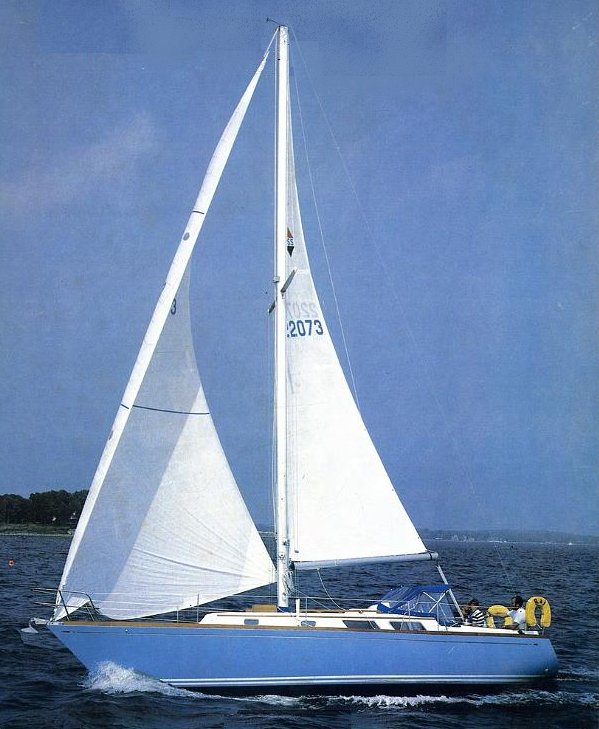No doubt owning a boat of any size is a luxury. This may be the reason some boat buyers arbitrarily assume all boats are designed and built to a level of quality that meets their own luxury standard. On the other hand, most consumers don’t expect the same level of quality of construction from a Chevrolet as they do from a Ferrari. For this reason, when discussing boats with clients, I have, on more than one occasion, made various analogies between boats and automobiles and, tacky or not, I’m about to do it again. Bristol Boat Company, of Bristol, RI, builds Lincolns, and the Bristol 35.5 may well be the Town Car of the Bristol line. Let’s take a look at the comparisons; it’s conservative in design, a little on the heavy side, offers smooth steady performance though not at break-neck speeds, and when you close a door you’re left with a comfortable feeling of a solid well built product. Last but not least, it’s expensive although not ridiculously over priced.
Between 1966 and 1977 Bristol Boat Company built a number of traditionally styled boats that were perhaps best exemplified by the classic Bristol 32 and Bristol 40 models. By the middle 1970s there was considerable market pressure to provide modern styling and greater accommodation. In late 1977, Bristol responded with the introduction of the Bristol 29.9 and Bristol 35.5 models. Over the years, through company ups and downs, Bristol offered models ranging from the Bristol 27.7 to the Bristol 65.5, and all generally following the same design concept. The Bristol 35.5 has stood the test of time and is still available as a new boat today, nearly 20 years after it was introduced.
The overall length of the 35.5 is, as might be expected, 35’ 6", beam is 10’ 10" and displacement is 15,000 lbs. As a centerboard model, sometimes designated as a 35.5C, the draft is 3’ 9" board up, and the deep draft keel version draws 5’ 9". The ballast/displacement ratio is 46% for the centerboard model and 43% for the fin keel model. Sail area to displacement ratio is 15.5, and displacement/length ratio is, by modern standards, a hefty 322. These are all very conservative numbers and result in a boat that has no extremes in her design, construction or performance.
The layout of the 35.5 offers a forward stateroom with a v-berth. The berth is large enough for two adults and is not pushed so far forward that your feet tangle into a cramped corner. Aft of the v-berth is an adequately sized head with integral shower followed by opposing settees in the main saloon. There are a navigation station and quarter berth aft along the port side and galley aft on the starboard side. The engine is located under the cockpit deck behind the companionway steps. Engine access, for such routine maintenance as changing the oil filter or adjusting the packing gland on the shaft, is poor. No doubt this is Yacht Design 101, standard layout "A". The simple reason it is used often is that it works well.
The hull of the Bristol 35.5 is constructed of solid laminate fiberglass and is built in two halves and joined on the centerline. The deck is fiberglass composite with balsa wood core and is securely fastened with nuts, bolts, and washers to the inward hull flange. This is a solidly built boat, and the lay-up schedule is substantial. Bristol has never made extensive use of fiberglass hull liners as a structural component, opting instead for a more traditional use of wood structural components. Full and partial bulkheads as well as other athwart ship and longitudinal members are bonded to the hull with fiberglass and resin. Secondary bonding is almost always flawless, and it is rare to find any significant structural problems with these boats. The centerboard installation on the 35.5 is quite loose and, with the board fully extended, the tip may move 3" or more to each side of a centerline. It is also common for the board to twist about 3 degrees within the trunk. This has always caused me some concern but failures, other than broken pennants, are rare. And who am I to question the wisdom of the Hood design team which is probably the most experienced designer of centerboard cruising boats in the world.
Despite her rather hefty displacement/length ratio and moderate sail area/displacement number, performance under sail of the 35.5 is quite good. The boat has a very respectable speed on all points of sail. She points well and is considerably faster than most boats of this displacement and length in light air conditions. Initially the 35.5 is quite tender and quick to heel, so it is important not to overpower the boat with large headsails.
Bristol 35.5s are always popular in the used boat market and hold their value very well.
Reviewed in the April 1997 issue of SpinSheet by Jack Hornor





